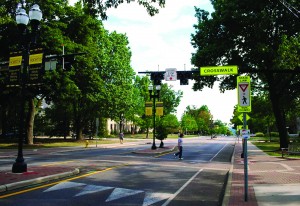 The newly installed stoplight promises a speedier commute for both those on foot and those driving in their car
The newly installed stoplight promises a speedier commute for both those on foot and those driving in their car
APEX is not the only new addition to the campus this year, with Beall Avenue now hosting a light at the crosswalk between Lowry Center and Gault Library. “What’ll happen is you’ll push a button and that’ll actually set everything in motion,” Director of Security and Protective Services Steve Glick explained.
The light differs from a more conventional stop light or crosswalk because the buttons located on either side are essential to the process. “You’ll be crossing the street, you’ll push the button and it’ll go through the cycle to stop traffic and then you’ll cross,” Glick said.
The light will also be useful in avoiding the creation of large traffic backups on Beall, one of the main roads that connects the city’s north side and downtown. The light will operate in such a way as to ensure that there is a steady flow of traffic, meaning that if one student presses the button and crosses, it goes through the whole cycle; another student immediately pressing the button will not engage another cycle. Instead, there will be a delay before the cycle can happen again.
Chief Glick is optimistic about the light’s impact, which allows both students to cross safely without backing up and delaying those using the road. “Hopefully, there will be a natural flow to the traffic, so long as students push the button. If it works as advertised, and students actually use it to cross, it’ll be a lot safer. And it’ll allow traffic, both vehicular and pedestrian, to move at an overall faster rate,” Glick said.
It will also eliminate the need of having SPS employees operate as crossing guards, though there will be an officer or two stationed there for the first few days. “We’re going to have people there initially to sort of remind them to push the button, just to show them what to do and get them in the habitat” Glick said. “The button, though easy to forget, is an important part of the process. It gets the whole cycle going.”
Once the light becomes operational and students fall into the habit of pressing the button, the light should ease problems with traffic on Beall. “Hopefully it should make crossing the street safer,” Glick said, though he did point out that the light is not a flawless system that automatically ensures safety. “You’ll still have to use due caution because students always lose when hit by a car, but overall, this should make it safer.”
